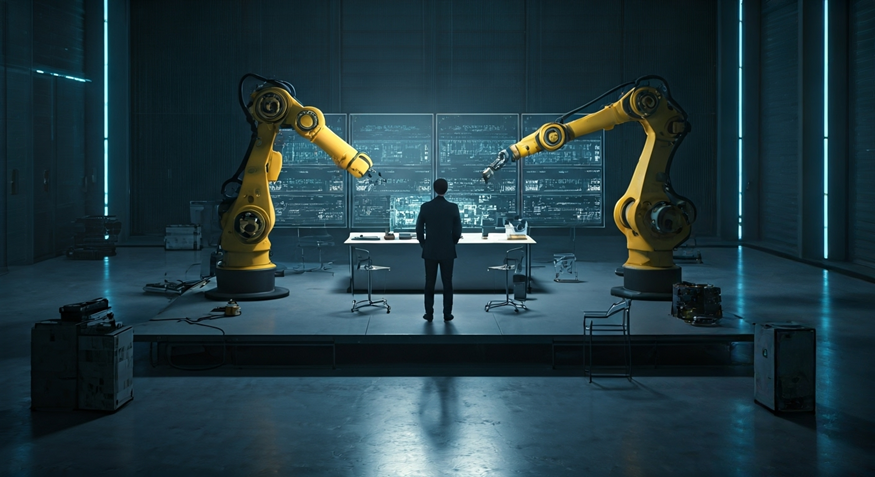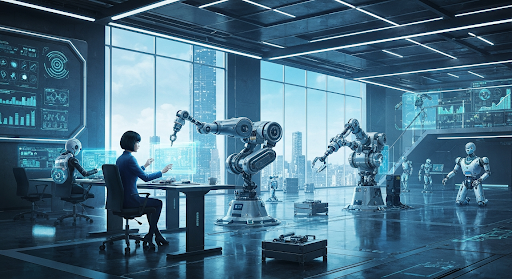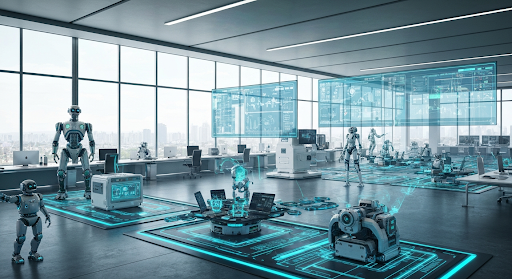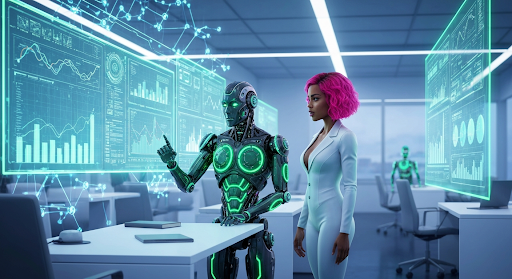The Future of Work: Robots Automation in Business
Key Highlights
- Robot automation and business process automation are transforming how companies operate, freeing humans from repetitive tasks and boosting efficiency.
- Process automation ranges from industrial robots in factories to intelligent process automation in offices using advanced automation technology.
- Business process automation leverages both hardware and software to streamline operations and reduce manual labor.
- Intelligent process automation integrates artificial intelligence and machine learning for smarter, adaptive automation solutions.
- The rise of automation technology is reshaping jobs, requiring employees to upskill and adapt to new work environments.
Introduction
The future of work is being shaped by digital transformation, with automation software and robotic process automation leading the charge. Businesses are rapidly adopting these technologies to optimize workflows, minimize errors, and enhance productivity. As automation spreads across both physical and virtual environments, it is redefining every aspect of business operations. This shift toward automated systems creates opportunities and challenges for companies and their employees alike, making it crucial to understand how robotic process automation is evolving the workplace.
Understanding Robots and Automation in Business

The business world is witnessing a shift as robotic automation and various types of automation become standard across industries. In today’s landscape, the automation process is not limited to manufacturing floors but extends to office tasks and service industries as well. This transformation redefines how physical robots, software bots, and integrated systems deliver value. To grasp how these technologies work together, let’s first explore the core concepts of robotics and automation solutions and see how each plays a distinct yet interconnected role in business.
Defining Robotics: Concepts and Key Features
Robotics blends engineering, computer science, and automation technology to build programmable machines, often called industrial robots. These machines interact with the physical world—lifting, assembling, welding, or sorting—bringing speed and consistency to tasks that were once labor-intensive.
At the heart of every robot are key components: sensors to perceive the environment, actuators for movement, and a control system that acts as the machine’s brain. The control system interprets data and instructs the robot on what actions to perform and when. These physical robots are reprogrammable, offering flexibility for different tasks.
Not all robots are fully autonomous. Some require continual human intervention, while others operate semi-autonomously or independently. As robots become more capable, they are increasingly trusted to manage complex physical processes in business settings. This evolution is driven by advances in computer science and automation software.
Types of Automation: From Industrial to Office Solutions
Automation comes in different forms, each tailored to specific business needs. Industrial automation focuses on machines handling physical processes, while software automation tackles virtual tasks often found in offices.
- Industrial automation: Uses machines or industrial robotics in production environments for material handling, assembling, and welding, reducing human error.
- Software automation: Employs software solutions like RPA bots to handle repetitive digital work—think data entry or scheduling.
- Robotic process automation (RPA): Software robots mimic human actions on computers, automating rule-based office tasks and processes.
- Intelligent process automation: Integrates artificial intelligence and machine learning, making process automation smarter and adaptive.
These automation solutions streamline operations, from the manufacturing floor to back-office functions, enabling organizations to focus their workforce on complex tasks.
Key Differences Between Robots and Automation
Although robots and automation technology often work side by side, they aren’t the same. Robots are hardware—physical machines designed to interact with the physical world—while automation spans both hardware and software. Software robots operate in digital environments, performing tasks without manual labor.
Understanding this distinction is vital when choosing the right automation process for your business needs. The next sections dive deeper into these differences and show how robots and automation technology can complement each other for greater efficiency.
Hardware vs. Software: What Sets Them Apart?
The main difference between robots and automation comes down to hardware versus software. Robots are physical devices engineered to perform tasks in the real world, such as manufacturing, logistics, and material handling. Automation technology, however, includes both physical and digital solutions.
Here’s a detailed text table to illustrate:
| Aspect | Robots (Hardware) | Automation (Software) |
|---|---|---|
| Nature | Physical robots, machines | Software robots, digital tools |
| Environment | Physical world, production environment | Virtual Tasks, office workflows |
| Example Tasks | Welding, assembling, picking, placing | Data entry, scheduling, analytics |
| Human Intervention | Sometimes needed (setup/maintenance) | Minimal, mostly self-running |
| Flexibility | Reprogrammable for physical tasks | Reconfigurable for new workflows |
Physical robots are rooted in hardware, tackling tangible processes, while software solutions automate tasks behind a screen—both reducing the need for human intervention but in different arenas.
Areas of Overlap and Integration
Despite their differences, robots and automation often overlap, especially in business process integration. For example, collaborative robots—sometimes called "cobots"—combine automation process technology with human work, supporting employees in repetitive or hazardous roles.
Many businesses implement automation by integrating both physical robots and software automation. In a warehouse, robotic automation might move goods, while RPA bots handle inventory updates in the system. This integration streamlines the entire business process, from material handling to order management.
Advances in intelligent process automation and machine learning have made it possible for these systems to work together even more efficiently. When robots and software automation are aligned, businesses can maximize output, minimize manual labor, and ensure human workers focus on tasks requiring judgment or creativity.
Current Applications of Robots and Automation in the Workplace

Robots and automation technology have moved far beyond the factory floor. Today, businesses use them to handle repetitive tasks, support business process automation, and even tap into machine learning for smarter operations. Whether it’s industrial robots assembling products or RPA bots streamlining digital workflows, automation solutions are changing how work gets done across industries. The following sections illustrate how these advancements are impacting both manufacturing and office environments.
Manufacturing, Logistics, and Warehousing
Manufacturing has long relied on industrial robotics to handle material handling and production environment duties. In this setting, robots excel at tasks like assembling, welding, and packaging, consistently outperforming humans in speed and precision.
In logistics and warehousing, robotic automation is reshaping how goods are sorted, stored, and shipped. Automated guided vehicles transport products across vast facilities, while robotic arms load and unload containers. These automation technologies minimize human error and reduce the physical strain on workers.
“Robots allow us to increase throughput and accuracy while letting our people focus on higher-value activities,” says Evan Beard, CEO. This blend of machine and human work has set new standards for efficiency and safety, driving the adoption of robot automation across the supply chain.
Office, Administrative, and Service Industries
Automation isn’t confined to the shop floor. In offices and service industries, RPA implementations are making a significant impact by eliminating tedious tasks. Software automation now handles digital processes that once ate up hours of employee time.
- Customer service: Chatbots and RPA bots handle routine inquiries, freeing human workers to resolve complex issues.
- Medical records management: Automation software organizes, retrieves, and updates records, reducing human error and boosting compliance.
- Financial services: RPA bots process transactions and analyze data for risk assessment, improving accuracy and saving time.
- Administrative work: RPA software automates form filling, appointment scheduling, and data entry, streamlining business process automation.
These automation solutions enhance productivity, lower costs, and allow teams to focus on tasks that require human judgment.
The Impact on the Workforce: Jobs, Skills, and Adaptation
As robots and automation technology advance, the workforce must adapt. While some roles are replaced, new opportunities arise, often demanding different skills. For employees, this shift means spending less time on repetitive business process tasks and more on creative or decision-driven work. Companies benefit from improved employee satisfaction and smoother business operations. Next, we’ll look at how job roles are changing and the importance of upskilling in this evolving landscape.
Job Displacement and Emerging Roles
With the expansion of robotic automation and process automation, some jobs are inevitably phased out. Repetitive, manual tasks in manufacturing, logistics, or data entry are most at risk of job displacement. However, this shift also brings new opportunities. Emerging roles focus on overseeing, programming, and maintaining these advanced systems.
Human workers are now expected to handle more complex tasks that require problem-solving, creativity, and human judgment. The digital transformation is leading to jobs such as automation engineers, RPA developers, and data analysts. These positions require an understanding of both the technology and the business process.
As repetitive roles diminish, employees must transition into positions that leverage their uniquely human skills. By embracing change and focusing on innovation, businesses can unlock new growth while supporting their workforce through this transition.
Upskilling, Reskilling, and Human-AI Collaboration
The adoption of intelligent process automation and automation technology demands a new approach to workforce development. Companies are investing in upskilling and reskilling to ensure their employees can thrive alongside automation.
- Upskilling: Training employees to use RPA software, analyze data, and manage machine learning systems.
- Reskilling: Helping staff transition from manual labor roles to overseeing business process automation or managing collaborative robots.
- Human-AI collaboration: Fostering environments where humans and intelligent systems work together, combining strengths for better outcomes.
- Process mining: Teaching teams to identify and optimize automation opportunities within their workflows.
This investment in people ensures that automation technology remains a tool for empowerment, not replacement. Human-AI collaboration is becoming central to business success, with employees and automation software working side by side.
Conclusion
The future of work is undoubtedly intertwined with the advancements in robots and automation. As businesses increasingly adopt these technologies, understanding their implications on the workforce becomes crucial. While there are concerns about job displacement, there is also potential for new roles and enhanced collaboration between humans and machines. Embracing upskilling and reskilling will be vital as we adapt to this evolving landscape. By harnessing the benefits of automation while addressing its challenges, organizations can create a more efficient and innovative workplace. If you’re eager to explore how your business can leverage automation effectively, get a free consultation today!
Frequently Asked Questions
Are robots replacing human workers entirely?
No, industrial robots and process automation are not eliminating the need for human workers. Instead, these technologies take over repetitive or hazardous tasks, allowing employees to focus on jobs that require human judgment and intervention. This shift can even boost overall employee satisfaction.
Can automation and robotics create new job opportunities?
Yes, automation and robotics often generate emerging roles, especially where human-AI collaboration is needed. Intelligent process automation and upskilling programs allow workers to spend less time on basic tasks and more time on strategic, creative, or technical roles.
What industries will be most affected by robots and automation in the future?
Industries like manufacturing (the production environment), financial services, and healthcare (medical records management) will see the greatest impact from industrial automation and the automation process. These sectors offer many repetitive tasks that can benefit from advanced automation solutions and robotics.



